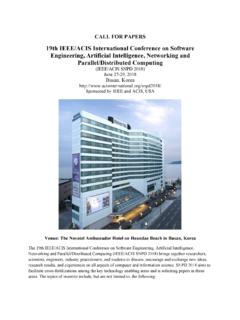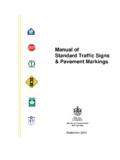Transcription of Instructions to Authors - ACIS International
1 Instructions to Authors December 2007 Document Template ..1 Manuscript Submission to Springer ..1 Writing Your Text ..2 Headings and Table of Abstract ..2 Technical Terms, Tables ..3 Equations ..3 Literal Text ..4 References ..4 Sources ..6 Figures and Illustration Data ..7 Checklist ..9 Document Template To help you do your work, a document template has been prepared by Springer for use with Word 2000 or 2003. Predefined style formats are available for all the necessary structures that are supposed to be part of the manuscript, and these formats can be quickly accessed via hotkeys or special toolbars. If you wish to create the final page layout in LaTeX, please refer to the respective in-structions and macro packages on our homepage.
2 Manuscript Submission to Springer To submit your files, please use a CD-ROM. Alternatively, you can use our FTP server (if you wish to do so, please contact Springer for further information). Save each chapter or contribution, including the accompanying references, figure legends, and tables, in a separate file in two formats: doc and rtf; do not submit docx files. The manuscript should additionally be submitted as pdf file with all the fonts embedded, especially if text or figures contain special characters or unusual fonts. Give each individual file your own name (or an abbreviation), the chapter number, and the format suffix, , or Save the figures separately. Please enclose a list of all the files with your submission. Keep personal copies of the files. 2 Instructions to Authors Writing Your Text Please use our Word template to prepare your text.
3 All the necessary formatting is already preset in the template. You can basically use all the functions in Word, particularly displayed lists, type styles such as bold or italics, the indexing function, and the footnote function. Only use the return key at the end of a paragraph or after headings, displayed lists, and the like. Do not insert manual hyphenation and do not use formats such as fram-ing, centering, or shading. Type Use a single main font for the entire text. We recommend Times Roman. For special characters, please use Symbol or Arial Unicode. Emphasis In running text, please set emphasized words or phrases in italic type. You can use Springer's document template to mark sentences or passages to be gi-ven special emphasis and quotations or case reports that are to be set in small type.
4 Length Please keep to the manuscript length agreed on with the publisher. Headings and Table of Contents A well-structured text and meaningful headings make it easier for the reader to get a general idea of the text. Please use the decimal system of headings with no more than four levels. 1 Chapter Section Subsection Sub-Subsection Additional levels of unnumbered headings can be marked using Springer's docu-ment template. Please list only the top three levels of headings in the table of contents. In cross-references, please give the chapter or section number ( , see Sect. ). Abstract Each chapter should be preceded by an abstract (10 15 lines long) that summarizes the content. The abstract will appear online at SpringerLink and be available with unre-stricted access.
5 This allows unregistered users to read the abstract as a teaser for the complete chapter. It will only appear in the printed edition if this is the style of the par-ticular book. Instructions to Authors 3 Technical Terms, abbreviations Ensure that the spelling of names, terms, and abbreviations is consistent, including in tables and figure legends. abbreviations , except for very commonly ones, must be defined the first time they are used and a list supplied with the manuscript. Please always use internationally accepted signs and symbols for units, so-called SI units. Chemical compounds should be named according to the systematic rules of the IUPAC or Chemical Abstracts. Please also note the following: Species and genus names, mathematical/physical variables, and prefixes in chemical compounds should be set in italic type (cis/trans, d/l, E/Z, o/m/p, R/S, t-Bu, tert-butyl).
6 L and D indicating optical activity should be set in SMALL CAPITALS (D- and L-dopa). Tables Number the tables consecutively using the chapter number ( , Table ) and en-sure that all the tables are cited in the text in the correct order. Give each table a heading. To format the table columns, use the table function. Do not use the space bar to separate columns, and do not use Excel to create tables. If a table cell is to be left empty, please type a hyphen ( - ) in it. Please do not treat simple, one-column lists as tables, but instead set them as part of the running text. Use the displayed list function instead. Save the tables in the same file as the text, references, and figure legends. Equations Equations of the type a2+b2=c2 can be written as normal text. For all other equations, please use MathType or the Microsoft equation editor, and insert the graphic into your text file as an object.
7 Prepare the whole equation in this way and not just part of it. Note: If you use Word 2007, do not create the equations with the default equation editor. Use MathType or the previous equation editor instead which can be accessed via Insert Object from the Insert ribbon. Please ensure the different styles are defined in the program itself: Style Font Bold Italic Text Times Function Times Variable Times x Symbol x Symbol Symbol Symbol Vector-Matrix Times x Number Times
8 4 Instructions to Authors When entering your equation, select the appropriate style for each character from the menu. Do not change the style settings in Style/Define. "Math" in the Style Menu covers the entries Function , Variable and Number ; the program will automati-cally style the character according to one of these styles. Do not insert the equation number from the equations editor. Please do not insert symbols or special characters that are not part of equations as graphics or using the formula editor if they are available as Symbol or Unicode fonts. Formulas/equations are numbered chapterwise. The formula number is given in pa-rentheses as right aligned text next to the formula (a+b)2 = a2+2ab+b2 ( ) If the equation is part of a sentence, the equation itself should end with a punctuation mark (not after the equation number).
9 Literal Text In order to distinguish the literal text of computer programs from running text, we rec-ommend using a font such as Arial or Helvetica. If you need a font for your programs in which every character has the same width, please use Courier. References References may be cited in the text in two different ways: Author name/s and year of publication in parentheses: one author: (Miller 1991), two Authors : (Miller and Smith 1994), three Authors or more: (Miller et al. 1995); Reference numbers in square brackets either sequential by citation or according to the sequence in an alphabetized list: [3, 7, 12]. Each chapter should contain a reference list of its own. Entries in the list must be listed alphabetically except in the numbered system of sequential citation. The rules for al-phabetization are: first, all works by the author alone, ordered chronologically by year of publication, next, all works by the author with a coauthor, ordered alphabetically by coauthor, finally, all works by the author with several coauthors, ordered chronologically by year of publication.
10 The reference list style depends on the subject of your book. Please refer to the in-formation below and ask your Springer contact if you are not sure which style should be used . Instructions to Authors 5 Medicine, Biomedicine, Life Sciences, Chemistry, Geosciences, Computer Science, Engineering, Economics Journal article Smith J, Jones M Jr, Houghton L et al (1999) Future of health insurance. N Engl J Med 965:325 329 Journal article only by DOI Slifka MK, Whitton JL (2000) Clinical implications of dysregulated cytokine produc-tion. J Mol Med. Book South J, Blass B (2001) The future of modern genomics. Blackwell, London Book chapter Brown B, Aaron M (2001) The politics of nature. In: Smith J (ed) The rise of modern genomics, 3rd edn. Wiley, New York Online document (no DOI available) Marshall TG, Marshall FE (2003) New treatments emerge as sarcoidosis yields up its secrets.



